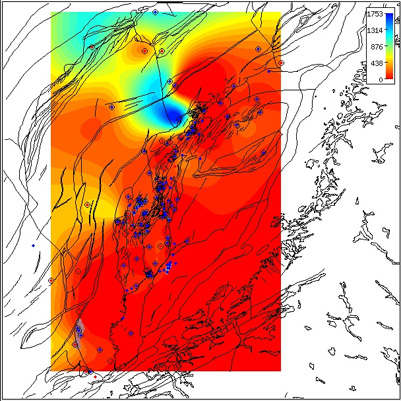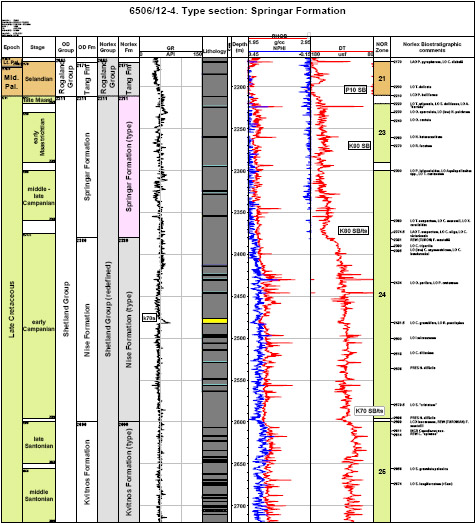Springar Formation
Shetland Group
Introduction
The definition of the Springar Formation follows Dalland et al. (1988). The formation is
generally a thick, widespread sequence of marine mudstones developed throughout the Norwegian
Sea region. Two new sandstone members are defined within this formation: the
Hvithval Member,
an interval of Maastrichtian - Campanian sandstones found in the Vøring Basin, and the
Grindhval Member, a unit of upper Maastrichtian sandstones present
in the Ormen Lange Field located in the Møre Basin.
Name
English/ Norwegian and any previous names: None
Derivatio nominis:
A Norwegian collective name for small whales (Dalland et al., 1988) or more accurately,
a group of toothed, sea going dolphins (Delphinidae) of the genus Lagenorhynchus e.g.
Kvitnos.
It has not been possible to use names from springar-types to define the two members since the
name Kvitnos is already occupied for an older formation. The names of the two new members:
Hvithval and Grindhval, are considered appropriate since these are also small to moderate sized
toothed whale species.
Lithology
The formation is predominantly of mudstones with rare limestone, dolomite and sandstone
stringers. The mudstones are light grey, occasionally dark grey, grey green, and red-brown,
generally soft, slightly plastic, amorphous, blocky, firm, subfissile, non to slightly
calcareous, slightly silty, occasionally micro-micaceous, with minor glauconite and pyrite. The
limestones are moderately argillaceous, predominantly soft-firm, clear white, firm to hard. The
dolomites are light brown, orange -brown, brown-yellow, firm to moderately hard and slightly
argillaceous. The minor sandstones are light brown, grey, predominantly loose, very fine to
fine quartz, moderately sorted with occasional calcareous or argillaceous cement.
Sample depository
Palynological preparations (organic matter depository)
Type well
6506/12-4:
11 slides (10 dc and 1 swc) from samples covering the interval 2220 m dc - 2375 m swc (Stratlab
preparations) available at the Norwegian Petroleum Directorate.
Reference well
6506/12-1:
31 slides (dc and 2 swc at 2337 m and 2415 m) from samples covering the interval 2280 m - 2440
m (Stratlab, RRI and OD preparations) available at the Norwegian Petroleum Directorate.
Core photographs
No cores were taken in either the designated type well 6506/12-4 or reference well 6506/12-1 in
this formation.
Thickness
The Springar Formation ranges in thickness from 9 m - 1753 m.

Regional isochore of the Springar Formation thickness in the Norwegian Sea based on released well data.
The isochore map is generated from Norlex data using thin plate splines (thickness constrained to original
range).
Thicknesses in metres.
Circled wells contain both top and base horizons.
The red wells have Norlex biostratigraphy. Click for large version.
Interactive Function:
Note that this map is only a regional interpretation and the user can generate more specific, local area
isochore maps
interactively within Norlex using the link below.
Interactive Norlex isochore map for the Springar Formation
|
Geographical distribution
The Springar Formation is widely distributed in the Norwegian Sea region. The thickness ranges
from 9 m in e.g.
6407/7-4 where it is truncated by
subsequent Paleocene erosion to the
exceptionally thick 1753 m, e.g.
6607/12-1 where the base of the
formation was not reached at
the well TD. The anomalous thickness is attributed to the well being drilled in a
mini-graben-like feature close to a fault plane on the western margin of the Dønna Terrace.
With the exception of well
6607/12-1, the greatest thicknesses
are typically in the Vøring
Basin where the formation contains sandstones of the
Hvithval Member. In this area the formation
still reaches thicknesses over 1000 m e.g.
6704/12-1. On the Halten and Dønna
Terrace areas, the
Springar Formation is typically between 100 m -200 m in thickness, diminishing
to less than 100m in the southern part of the Halten Terrace e.g.
6306/6-1 and around the Nordland
Ridge where it is thin or locally absent e.g.
6608/11-1.
Sandstones of the Hvithval Member are geographically restricted to
the Vøring Basin and those
of the Grindhval Member are locally developed in the Møre Basin.
Occurrences of formation tops in wells
Type well
Well name: 6506/12-4
WGS84 coordinates: N 65°12'46.97, E 06°43'30.37
UTM coordinates: 7234298.1 N 393591.29 E
UTM zone: 32
Drilling operator name: Den norske stats oljeselskap a.s. (Statoil a.s.)
Completion date: 13.08.1985
Status: P & A
Interval of type section & thickness in type well:
2380 m - 2211 m, 169 m thickness.

Click for large version (PDF)
Reference well
Well name: 6506/12-1
WGS84 coordinates: N 65°10'07.58, E 06°43'44.07
UTM coordinates: 7229359.52 N 393591.68 E
UTM zone: 32
Drilling operator name: Den norske stats oljeselskap a.s. (Statoil a.s.)
Completion date: 06.02.1985
Status: P & A
Interval of type section & thickness in reference well:
2446 m - 2279 m, 167 m thickness.

Click for large version (PDF)
Upper and lower boundaries
Upper Boundary
The top of the Springar Formation coincides with the top of the
Shetland Group and the
Cretaceous/Paleogene boundary. This is normally a stratigraphic break of varying extent, but
Danian sediments are typically absent in wells in the Halten Terrace - Dønna Terrace areas. The
boundary with the overlying Tang Formation is usually defined by a
marked downward decrease in
sonic velocity and increase in density values reflecting the unconformity. Limestones are
generally more prominent in the Springar Formation than the overlying Tang Formation and
frequently a limestone stringer defines the top surface.
Lower Boundary
The base of the Springar Formation and boundary with the underlying
Nise Formation is normally
defined by a prominent downward increase in sonic velocity. There is typically no gamma ray
response at this level but the sonic log change is generally associated with a
minor increase in density.
Well log characteristics
The Springar Formation is a relatively distinct unit of mainly mudstones characterised by a
relatively uniform sonic velocity developed between the Nise and
Tang Formations. The gamma-ray values are generally more variable.
Type seismic section
Biostratigraphy
The lower boundary of the Springar Formation appears to be close to the top of the early
Campanian as defined by the dinoflagellate cyst event LAO Trithyrodinium suspectum.
This is the key marker for the base of the Springar Formation.
In complete sections unaffected by erosion in response to the base Cenozoic/top Cretaceous
unconformity e.g. Ormen Lange well 635/5-1, the upper boundary of the Springer Formation is
late Maastrichtian age and characterised by the last occurrence of planktonic foraminifera
notably LO Rosita contusa, LO Abathomphalus mayaronsis, LO Racemiguembelina
fructicosa, LO
Globigerinelloides asper, LO Heterohelix spp. and the dinocyst LO Palynodinium
grallator (Zone
23). In the area of the type and reference wells located on the western margin of the
Trøndelags Platform, the top of the Springer Formation is truncated and of early Maastrichtian
or intra-late Maastrichtian age defined by the LO Triblastula utinensis, LO
Odontochitina
operculata and/or Hystrichodinium pulchrum. The stratigraphic break with the
overlying
onlapping sediments of the Middle Paleocene Tang Formation is in the order of 10 m.y. duration.
Age
Late Cretaceous, early Campanian to late Maastrichtian.
Correlation
The Springar Formation is laterally equivalent to the siliclastic
Jorsalfare Formation, upper
Kyrre Formation and more carbonate-rich
Hardråde Formation developed in the northern North Sea
region. It is also a time equivalent of the
Tor and Magne Formations (formerly uppermost
Hod Formation) in the Chalk Group.
Depositional environment
The Springar Formation was generally deposited in a deep outer shelf to bathyal
palaeoenvironment, with restricted water circulation. There are indications of temporary
periods of more open marine circulation in response to the episodic opening of the Cretaceous
seaway between Norway and Greenland (Gradstein et al., 1999).
Deep water, non-calcareous agglutinated foraminifera (DWAF) dominate the microfauna with
calcareous benthonic foraminifera, planktonic foraminifera and radiolarians present at certain
levels.
Remarks
The Springar Formation is widely distributed in the Norwegian Sea area, and represents
deposition during the entire K5 sequence of Swiecicki et al. (1998), K95 and K100 of
Vergara et al. (2001) and K80 and K90 sequences of Færseth and Lien (2001).
References
Dalland, A., Worsley, D. and Ofstad, K. 1988. A lithostratigraphic scheme for the Mesozoic and
Cenozoic succession offshore Mid and Northern Norway. Bulletin of the Norwegian Petroleum
Directorate, Bulletin No. 4, 1-65.
Færseth, R. and Lien, T. 2002 Cretaceous evolution in the Norwegian Sea - a period
characterized by tectonic quiescence. Marine and Petroleum Geology, 19, 1005 -1027.
Gradstein, F., Kaminski, M.A. and Agterberg, F.P. 1999. Biostratigraphy and paleoceanography of
the Cretaceous seaway between Norway and Greenland. Earth-Science Reviews, 46, 27-98.
Swiecicki, T., Gibbs, P.B., Farrow, G.E. and Coward, M.P. 1998. A tectonostratigraphic
framework for the Mid-Norway region. Marine and Petroleum Geology, 15, 245-276.
Vergara, L., Wreglesworth, I., Trayfoot, M., Richardsen, G. 2001. The distribution of
Cretaceous and Paleocene deep-water reservoirs in the Norwegian Sea basins. Petroleum
Geoscience, 7, 395-408.



